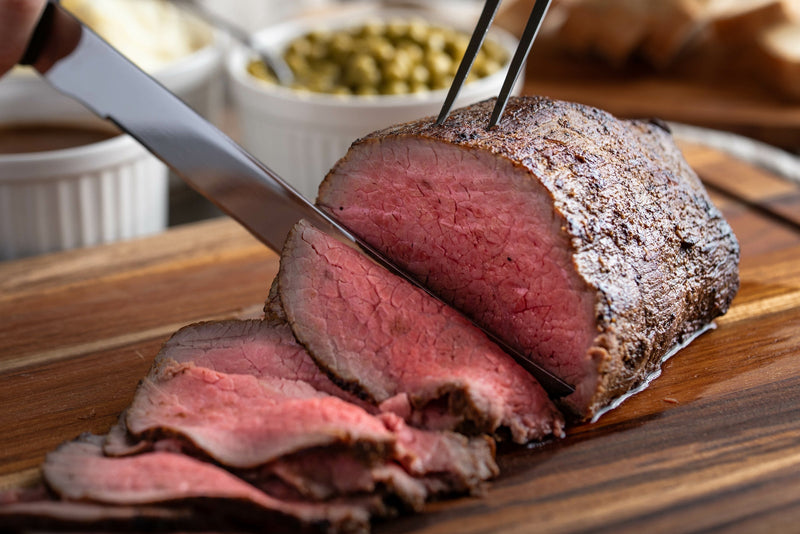
There’s something undeniably special about dry-aged beef. The rich, deep flavor. The tenderness. The way it feels like a true experience, not just another dinner. If you’ve ever wondered what makes dry-aged beef different — or how to cook it to bring out all that flavor — let’s dig in.
What Is Dry-Aged Beef?
Dry-aged beef is beef that has been stored in a temperature- and humidity-controlled environment for a period of time — typically 21 to 45 days, though some go longer. At Midwest Prime Farms, we age our Angus beef rib and loin section for 30 days, which we’ve found to be the perfect sweet spot for deep flavor and tenderness.
During this time, two things happen:
- Moisture evaporates from the muscle, concentrating the beefy flavor.
- Natural enzymes break down connective tissues, making the meat incredibly tender.
The result? A steak that’s richer, more tender, and more flavorful than anything you’ve had before. Some describe dry-aged beef as having a nuttier, almost buttery flavor — it’s bold, yet refined.
Is Dry-Aged Beef Cooked Differently?
Yes — and no.
You can cook dry-aged beef just like any other steak, but a few simple tweaks will help you get the most out of it:
-
Keep it simple. Let the beef shine. A little salt, pepper, and maybe a touch of garlic is all you need.
-
Don’t overcook it. Dry-aged beef cooks slightly faster because it has less moisture. Aim for medium-rare to medium.
-
Bring it to room temp first. This helps it cook evenly.
-
Let it rest. After cooking, let the meat rest for 5-10 minutes before slicing.
Want an easy go-to method? Try searing it in a cast iron skillet with a little butter or beef tallow, then finish in the oven. Or throw it on a hot grill and let the fire do its thing. High quality beef doesn't need much, it's perfect the way that it is!
Dry Aged vs. Wet Aged Beef: What’s the Difference?
Most store-bought beef is wet aged, which means it’s vacuum-sealed and aged in its own juices. It’s faster, more convenient, and cheaper — but it doesn’t develop that same concentrated flavor or tenderness that dry aging offers.
Here’s a quick breakdown:
| Feature | Dry-Aged Beef | Wet-Aged Beef |
| Aging Method | Exposed to air in a controlled environment | Sealed in plastic |
| Flavor | Deep, rich, nutty, bold | Mild, more traditional |
| Texture | Tender, with a firmer bite | Slightly more moisture, less tender |
| Time | 21–45 days | 7–21 days |
| Cost | Higher | Lower |
Think of it like cheese: cheddar that’s been aged a year has way more depth than a fresh one. Same idea.
When to Choose Dry-Aged Beef
Dry-aged beef is perfect for those times when a meal is more than a meal — when you want to celebrate, connect, or simply treat yourself.
Some of our customers love serving it for:
-
Anniversaries or date nights at home
-
Father’s Day or birthday cookouts
-
Holiday dinners (try a dry-aged prime rib roast — it's incredible)
-
Grilling season — because it’s grilling season
If you're ready to experience it for yourself, check out our collection of Dry-Aged Angus Beef here. From thick-cut ribeyes to tender filet mignon, every cut is aged 30 days and comes from our pasture-raised Angus cattle.
Taste the Difference with Midwest Prime Farms
We raise our cattle right here on our Indiana family farm, with care and intention every step of the way — no shortcuts. Our dry-aged beef is a true farm-to-table experience, and once you taste it, you’ll never go back.
➡️ Shop our Dry Aged Beef Collection
Have questions about cuts, cooking tips, or what to try first? Stop by The Market by Midwest Prime, send us a message, or follow along on Instagram for behind-the-scenes looks at farm life and the dry-aging process.


